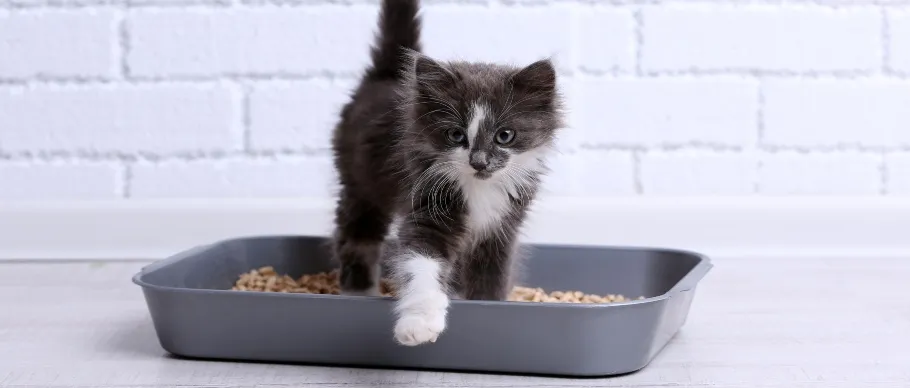Successfully housetraining a cat is one of the most rewarding aspects of pet ownership. Unlike puppies, kittens often master the litter box quickly, simplifying life for both pets and owners. While it’s a common belief that mother cats instinctively teach their kittens this skill, this isn’t always the case. Whether you’ve recently adopted a kitten or brought home a cat of any age, some level of litter box training is usually necessary.
Key Takeaways
- Choose a litter box that suits your cat’s breed, age, and weight.
- Gather essential supplies: a litter box, cat litter, cat pads, and a litter scoop.
- Clumping litter is highly popular due to its ability to bind when wet.
- Ensure at least 2 inches of litter in the box, allowing your cat to cover their mess.
- Cats generally prefer their litter box in a quiet location, separate from their food and water.
- If initial training proves unsuccessful, consider relocating the litter box or trying a different type of litter.
Before You Start: Gather Your Supplies
To begin litter box training your cat, you’ll need a few essential items:
- Litter Box: Available in various styles, from open pans to enclosed spaces and corner-fitting designs that conserve space and offer privacy.
- Cat Litter: Numerous varieties exist. Clumping litter is a top choice for convenience as it solidifies when wet, forming clumps that are easy to remove.
- Cat Pads: These can provide an extra layer of protection against messes. Place them under the litter box to catch any spills or track-away litter. Some specialized pads are designed for litter box systems, offering enhanced odor control and easier cleanup.
- Litter Scoop: A sifting litter scoop is particularly useful, allowing you to easily remove waste without replacing all the litter daily.
When selecting a litter box, consider size. As a general guideline, opt for a box that is at least one and a half times the length of your cat. This provides ample space for your feline friend to comfortably turn around, dig, and cover their waste.
4 Steps to Litter Box Training
 Kitten leaving litter box
Kitten leaving litter box
Step #1: Strategic Placement
The first crucial step is selecting the optimal location for the litter box. Cats are naturally inclined to seek out quiet, private areas for elimination. It’s also important to position the box away from your cat’s food and water bowls, as most cats prefer not to relieve themselves in the same vicinity where they eat. Some cats may even refuse to use a litter box if it is too close to their feeding area.
Step #2: Add Sufficient Litter
Fill the bottom of the litter box with approximately 2 inches of cat litter. Since cats have a natural instinct to bury their waste, providing enough litter is essential for them to fulfill this behavior. Once the box is prepared, gently place your cat inside to allow them to acclimate to the scent and texture of the litter. Don’t be discouraged if they don’t use the box immediately; some kittens may require a few minutes to settle in.
Step #3: Consistent Encouragement
Continue placing your cat in the litter box several times a day. Key times to encourage use are shortly after your cat has eaten, as kittens, in particular, often need to eliminate soon after meals. If you observe your cat starting to eliminate elsewhere in the house, gently interrupt them and guide them to their designated litter box. Be sure to offer praise and positive reinforcement whenever they successfully use the box.
Step #4: Troubleshooting and Adjustments
If you are encountering difficulties with the training process, don’t hesitate to make adjustments. You might need to relocate the litter box to a different spot in the house or experiment with a different type of cat litter. Sometimes, a change in location or litter can make all the difference in encouraging your cat to use their box consistently.
How to Clean the Litter Box
Regular cleaning of the litter box is vital for your cat’s health and hygiene. Each time you notice your cat has used the box, use your scoop to remove the waste. After cleaning, you may need to add a small amount of fresh litter to maintain the optimal depth for your cat to bury their mess.
A thorough weekly cleaning is also recommended to keep the litter box fresh and odor-free. This practice can also help reduce the risk of your cat developing a UTI due to bacterial buildup. To perform a weekly clean, empty all the old litter into the trash, wash the box with a pet-safe cleaner, and refill it with fresh litter.
Purr-fect Job!
Consistent effort and understanding your cat’s habits will lead to success in litter box training. Remember to observe your cat’s routine and the times they typically need to “go.” With patience and consistency, your feline companion will soon be reliably using their litter box on their own. For more tips on ensuring your kitten’s well-being, consider learning how to teach a kitten to drink water.
